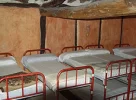- Time of past OR future Camino
- Various routes 2016 - 2024
Note: when you post a misconception please start with "it's a misconception that..." to lessen any confusion
Here's a thread to (hopefully) dispel some common Camino misconceptions.
Off the top of my head some of the more common misconceptions are:
You need to follow guidebook stages. Nope. Guidebooks have stages possibly because those are the stages that the guidebook author prefers, it's an easy way to organize the information, etc. You can stop for the night wherever you want. Check a guidebook, website like Gronze.com, or app to make sure that your stopping place offers the services that you need.
You need special equipment to walk across the Pyrenees. No, while the initial ascent from SJPdP is very steep, much of it is on a paved road. This is not mountaineering.
Private albergues are always nicer than public, municipal or parochial albergues. Many public albergues are updated with newer beds, bathrooms, etc., while there are private albergues in a state of disrepair. Check out public albergues like Roncesvalles which was remodeled in recent years and features bunks in cubicles of four beds with a locker for each bed, modern bathrooms, and a large laundry room. Or Azofra municipal with rooms of two single beds in each (no bunks!) and a lovely patio with fountain. The large municipal albergue in Burgos is also recently updated. And the purpose built municipal albergue in Dumbría is stunning.
Compare to some private albergues pictured here:



You must start the Camino Francés in St Jean Pied de Port, the Norte in Irun, the VdlP in Seville, etc. The Camino starts wherever you want it to start. The only "rule" is if you want to receive a Compostela you must walk or ride horseback for at least the final 100 km or cycle at least 200 km into Santiago, and make the pilgrimage for religious or spiritual reasons, or at least an attitude of search. If you aren't walking for those reasons you can still receive a lovely certificate of welcome when you arrive in Santiago, and for 3 euros a distance certificate.
You don't need two stamps a day to receive a Compostela if you start in SJPdP, León, Irun, etc. Not true. The pilgrim's office is clear: You have to stamp the Credencial twice a day at least on the last 100 km (for pilgrims on foot or on horseback) or on the last 200 km (for cyclists pilgrims).
Here's a thread to (hopefully) dispel some common Camino misconceptions.
Off the top of my head some of the more common misconceptions are:
You need to follow guidebook stages. Nope. Guidebooks have stages possibly because those are the stages that the guidebook author prefers, it's an easy way to organize the information, etc. You can stop for the night wherever you want. Check a guidebook, website like Gronze.com, or app to make sure that your stopping place offers the services that you need.
You need special equipment to walk across the Pyrenees. No, while the initial ascent from SJPdP is very steep, much of it is on a paved road. This is not mountaineering.
Private albergues are always nicer than public, municipal or parochial albergues. Many public albergues are updated with newer beds, bathrooms, etc., while there are private albergues in a state of disrepair. Check out public albergues like Roncesvalles which was remodeled in recent years and features bunks in cubicles of four beds with a locker for each bed, modern bathrooms, and a large laundry room. Or Azofra municipal with rooms of two single beds in each (no bunks!) and a lovely patio with fountain. The large municipal albergue in Burgos is also recently updated. And the purpose built municipal albergue in Dumbría is stunning.
Compare to some private albergues pictured here:



You must start the Camino Francés in St Jean Pied de Port, the Norte in Irun, the VdlP in Seville, etc. The Camino starts wherever you want it to start. The only "rule" is if you want to receive a Compostela you must walk or ride horseback for at least the final 100 km or cycle at least 200 km into Santiago, and make the pilgrimage for religious or spiritual reasons, or at least an attitude of search. If you aren't walking for those reasons you can still receive a lovely certificate of welcome when you arrive in Santiago, and for 3 euros a distance certificate.
You don't need two stamps a day to receive a Compostela if you start in SJPdP, León, Irun, etc. Not true. The pilgrim's office is clear: You have to stamp the Credencial twice a day at least on the last 100 km (for pilgrims on foot or on horseback) or on the last 200 km (for cyclists pilgrims).
Last edited:
























